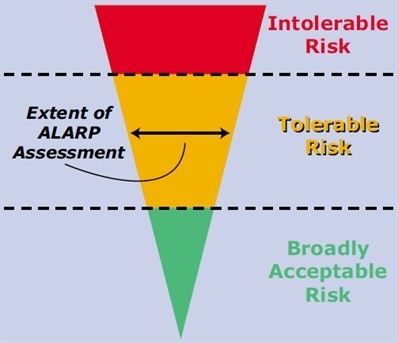ALARP stands for “as low as reasonably practicable“, and is a term often used in health and safety to represent that adequate consideration shall be taken in regard to risk, risk control and risk reduction. The core is the concept of “reasonably practicable”; this involves weighing a risk against the trouble, time and money needed to control it. Thus, ALARP describes the level to which you would expect to see workplace risk controlled. ALARP is not prescriptive and consequently can be challenging because it requires employers to exercise judgement. It is therefore for employers to ensure that their chosen design or design concept reduce risks “as low as reasonably practicable”.
The “ALARP region” lies between unacceptably high and negligible risk levels. Even if a level of risk for a “baseline case” has been judged to be in this ALARP region it is still necessary to consider introducing further risk reduction measures to drive the remaining, or “residual”, risk downwards.
The ALARP level is reached when the time, trouble and cost of further reduction measures become unreasonably disproportionate to the additional risk reduction obtained.
Factors
In this context, a risk is the combination of the frequency and the consequence of a specified hazardous event. The following factors are likely to be considered when deciding whether or not a risk is tolerable.
- Health and safety guidelines
- The specification
- International standards and laws
- Suggestions from advisory bodies
- Comparison with similar hazardous events in other industries
Another factor that comes into the ALARP principle, is the cost of assessing the improvement gained in an attempted risk reduction. In extremely complex systems, this can be very high, and could be the limiting factor in the practicability of risk reduction.
Determining that a risk has been reduced to ALARP involves an assessment of the risk to be avoided, of the sacrifice (in money, time and trouble) involved in taking measures to avoid that risk, and a comparison of the two. This is a cost-benefit analysis. (Text Source: en.wikipedia)
Why do I need to know about ALARP?
The concept of “reasonably practicable” lies at the heart of the British health and safety system. It is a key part of the general duties of the Health and Safety at Work etc. Act 1974 and many sets of health and safety regulations that we and Local Authorities enforce. HSC’s policy is that any proposed regulatory action (Regulations, ACOPs, guidance, campaigns, etc.) should be based on what is reasonably practicable. In some cases, however, this may not be possible because the Regulations implement a European directive or another international measure that adopt a risk control standard different from “reasonably practicable” (i.e. different from what is ALARP).
Because ALARP is fundamental to the work of the whole organisation, it is important that everyone, whatever their role, knows about it. Here are some specific reasons for you to know about ALARP and its relationship with good practice, but this is not an exhaustive list.
- Policy makers and those engaged in Programme delivery need to know about ALARP because when you make proposals for HSC/E action to control health or safety risks, you need to make sure that, as far as possible, those controls will reduce the risks to employees (or other people, as the case may be) ALARP.
- Enforcers need to know about ALARP because you will have to decide whether duty-holders have reduced their risks ALARP and so have complied with the law.
- Technical specialists in HSE need to know about ALARP because you advise colleagues in HSE about whether control measures reduce risks ALARP and you help identify standards of risk control that are ALARP.


Leave a Reply